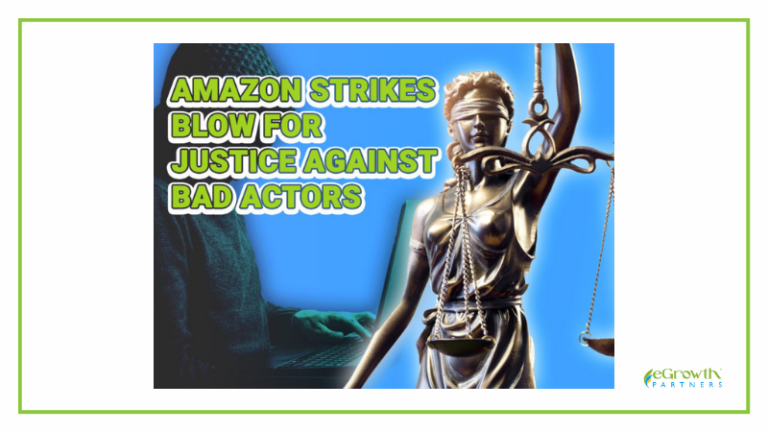Friday’s news that six consultants were indicted by the United States District Court for the Western District of Washington at Seattle was like a bomb going off in the seller community. Well-known consultants Ephraim “Ed” Rosenberg, Joseph “Joe” Nilsen, and Kristen “Kristen Michelle” Leccese face an array of charges alleging conspiracy, bribery, fraud, theft and facilitating attacks against other 3P sellers.
This is not just a crime in Amazon’s court or in the state of Washington; it’s a federal crime. The court alleges they wired illicit money across state and country lines, they committed bribery across state and country lines and they committed cybercrimes and theft across state and country lines. They are each looking at up to 25 years in jail if proven guilty plus they must return the money and pay fines.
In this blog I’m focusing on what the charges are and what these actors allegedly have done because the details are helpful to the community.
The tactics listed here are used by bad actors worldwide in our industry. My clients have suffered from perpetrators in Russia, Ukraine, the US and China.
Why is this indictment good news for sellers?
- Amazon supported sellers. They took out some alleged bad actors on behalf of the seller community.
- Creates Chilling effect. This will hopefully give some bad actors pause as more indictments are possible..
- Explains the trick: The details shared in the indictment help sellers recognize other bad actors they might come up against in the future.
- Re-Levels the Playing Field: It takes away an unfair advantage that the bad actors had over other sellers and consultants in the industry.
- Diminishes Threats and intimidation. Bad actors don’t want to be caught, obviously. As stated in the indictment, If you didn’t do what they said, they would allegedly threaten and intimidate you. (see example from indictment below). Some of that threat is lessened, today, by the fact that Amazon is listening to sellers about bad actor behavior.
I read the 38-page indictment and it’s a John Grisham novel in the making. For years I’ve talked and written about Dirty Seller Tricks℠ (check out Dirty Seller Tricks Taking Down More Sellers on Amazon and Dirty dealing in the $175 billion Amazon Marketplace) because the damage to sellers committed by bad actors is extreme. Sellers have lost their businesses or been severely crippled. Sellers have lost their intellectual property to liars and cheaters. Good sellers have left the platform because it wasn’t a fair playing field.
Here’s what the indictment teaches us:
Eight Red Flags of Amazon Bad Actors when Vetting a Service Provider
- They guarantee success. No one can guarantee what Amazon will do unless they are bribing someone on the inside. No one. They can offer to refund you if they fail, but they can’t guarantee that Amazon will reinstate you.
- They have secret inside contacts. This is always a bad sign. As a community, Amazon consultants have learned some email addresses that can help escalate a case but they are generally well known, legitimate and not being bribed – like [email protected] (which is currently turned off to sellers right now). If a provider has given you names and emails, at least check them out on LinkedIn. We’ve seen names that some of our competitors are using and they are in no position to help a seller legitimately. They are in the wrong department, are too low level, etc. If they are truly helping sellers, they might be being bribed to do so. Be careful.
- They offer services against terms of service (TOS). We’ve seen Amazon consultants offer to create stealth accounts that Amazon won’t catch, to get you on page one in two weeks, to dramatically increase your product reviews, to fool the algorithm, to increase your rank, get you buyer information so you can market to buyers, etc. While what they are offering might not be against terms of service, claims like this tell you to dig deeper. Stealth accounts are against TOS. Period. Review or ranking claims require scrutiny: they may be legit; they might not be. Understand how they do it and compare it to Amazon’s TOS before signing up.
- It’s too good to be true. This is slightly different from guaranteeing their work. In this case they claim something that isn’t possible to do. For example, the indictment alleges the defendants got their clients thousands of reimbursement dollars to which they were not entitled. The indictment explains how they did that by manipulating Amazon’s computers such that they erased shipping tracking information from Amazon’s computer network which induced Amazon to falsely conclude that it had not returned certain inventory to 3P sellers. When the new claim came in for inventory lost in transit, Amazon paid out thousands of dollars. If you don’t know how a provider is getting such great results, it’s a flag. Ask questions.
- They help you take down unwanted sellers through Intellectual Property claims. Brands need to be very careful. Abuse of Amazon’s brand registry is backfiring as sellers fight back and win lawsuits against abusive brands. Make sure whoever you work with is compliant with Amazon’s TOS and that innocent sellers buying from lawful sources (including retail arbitrage) are not going to be hurt. There are lawful ways to achieve your goals. Make sure your partner is following them.
- They are invisible. Some consultants hide behind their websites. You don’t know who you are working with. They don’t speak publicly, there’s no way to reach them except by email or phone, they don’t have an address on their website…these are all red flags. One of my competitors is a convicted felon who served three years for fraud. You can find that through a simple google search. A legit provider has nothing to hide. Their name, phone number, address, email, and employees are all on their website. You’ve met them on the conference circuit, they’ve written papers and blogs and books. They are quoted by the media.
- They associate with other bad actors. It’s not conclusive, but it is a flag if a service provider is hosting webinars and promoting other people’s black hat webinars and masterminds to their database. Birds of a feather flock together as the old saying goes.
- They require cash. Most service providers take credit cards, PayPal, etc. If someone is requiring cash or will only take a wire transfer or is having you wire money out of the country, that’s a flag.
I hope that’s helpful to the community. If you see multiple flags or if you ask questions and are not satisfied with the answers, find someone else to work with. Most bad actors aren’t going to be obvious about what they are offering until they are sure you are on board. I think it is safe to say that the seller who paid $200K to get reinstated knew exactly what was going on. But there may be others who had no idea and I hope they are spared retribution by Amazon.
What are the Dirty Seller Tricks℠ in the indictment?
This is the primary reason I encourage sellers to read the indictment because the alleged tricks will hopefully help you avoid getting taken in by other bad actors still out there, and recognize them when you see them.
Stolen Amazon Data
Amazon alleges that terabytes of data on hundreds of account annotations, competitors (sales, advertising and more), SOPs, internal Wikis, details on the algorithm, getting the buy box, Amazon’s search engine, product review ranking, seller performance processes and criteria for reinstatement, and buyers was stolen and sold to 3P sellers by these conspirators. They also allegedly shared and sold this data within their professional networks. If anyone tells you they can get your account annotations or details on your account or a competitor’s; they are bribing someone for it.
Account and ASIN Reinstatements
Amazon claims that since the baseless and fraudulent reinstatement of these hundreds of ASINs and Accounts, these listings and accounts have generated over $100 million in total revenue from sales on the platform. The defendants allegedly bribed Amazonians to achieve this result. Amazon specifically listed takedowns for counterfeit, safety, IP complaints and review manipulation as well as “other” violations of the seller code of conduct.
Lifted Restrictions
This includes getting sellers into restricted categories and waiving Amazon inventory limitations and fees relating to the amount of inventory, including hazmat inventory, oversized inventory and long-term inventory, that sellers may store at Amazon’s warehouses. Amazon claimed that the defendants used stolen (from Amazon’s database of invoices), fraudulent and forged supplier invoices to ungate sellers.
Attacks Against Other Sellers
Amazon alleges that the defendants and other consultants and 3P sellers bribed Amazon insiders to attack other 3P sellers and their listings to gain an unfair advantage.
Among other things, the insiders would suspend seller accounts and listings.
They flooded their listings with fraudulent customer reviews designed to hurt sales and/or get the seller suspended.
They put hundreds of fraudulent positive reviews on their clients’ accounts.
They also replaced sellers’ ASIN images with frightening, obscene and lewd images designed to turn buyers away and intimidate the victims.

I have seen many, many cases of these black hat tactics among our clients. These are despicable tactics. Even when the pictures are fixed, the seller may have dozens of negative reviews from angry potential buyers on their listings to contend with. Many times, their products never fully recover. Often, we would get the problem fixed for our clients and within hours – sometimes minutes – the pictures were back again.
Amazon alleged in the indictment that “Client 1” offered members of the conspiracy $35K in cash to “wipe out” “victim 1.” Here’s what they did:
- Stole information about Victim 1 from Amazon
- Registered the URL “globebrandlawgroup.com”
- Submitted a false IP complaint about Victim 1 to Amazon from “Globe Brand Law Group”
- Amazon suspended Victim 1’s account
Amazon alleged that “Consultant 1” collaborated with the conspirators to send an intimidating message to “Victim 2” and Consultant 1’s other clients because of an unpaid service bill. Here’s what they did:

- Nilsen uploaded a flat file to replace Victim 2’s product listings with lewd and vulgar images including a smiley face with an upright middle finger.
- Once Victim 2 paid his bill to Consultant 1, the account was restored to its original state
Amazon alleged that “Consultant 1” collaborated with the conspirators on behalf of “Client 4” who wired $25K to Joe Nilsen. Here’s what they did to Victim 3:
- Stole information about Victim 3 from Amazon
- Used sham buyer accounts to purchase from Victim 3 and leave negative reviews and fraudulent complaints filled with keywords designed to get the listings and, possibly, the account shut down.
- Hired Consultant 2 who is located outside the country for $5000 to help in the attacks.
Buyer Harassment
Amazon alleges that the defendants acquired buyer’s information – particularly those who left negative reviews – such that the seller could either harass the buyer to change their negative review, or use the lists to market directly to the buyer to buy more product from the seller either on Amazon or their own website.
Stealth Accounts
It is alleged that Joe and co-conspirator Hadis Nuhanovic had numerous 3P accounts in their names, the names of others and dozens of aliases that they used to conceal their identities and association with these 3P accounts from Amazon. Why so many accounts? The indictment does not say but we have seen other bad actors use multiple accounts to squeeze out competition, employ shady marketing tricks and more. I call it “the shell game.” In Amazon’s world just having these accounts is disallowed. Perhaps we will find out in the trial how they were used. In Nuhanovic’s case, he was banned from the platform for fraud in August 2018 which is why he used stealth accounts. Kristen Leccese also operated “numerous” 3P accounts on the platform.
Improper Reimbursements
As mentioned earlier, it is alleged that the defendants manipulated Amazon’s computers to get unearned reimbursements for sellers. They erased shipping information and then made “lost in transit” claims with Amazon.
Negative Product Review Removals
In addition to gathering lists of buyer names for sellers, the indictment alleges that Amazonians were sometimes bribed to remove negative reviews from sellers’ listings.
Fake Appeals
This is where the defendants allegedly made false statements in the appeals that were submitted to Amazon on behalf of their clients. They also repeated those falsehoods to Amazon over the phone and by video and other emails seeking help for “Client 1.”
Fraudulent Wire Transfers
This is not a dirty seller trick, but I found it interesting that the defendants allegedly had multiple aliases and used them to transfer money and hide their activity from banking and law enforcement agencies. Criminals do that.
Cynthia’s Thoughts on this Indictment
While we all learned from Law & Order that a prosecutor – or US Attorney Brian Moran in this case –could get an indictment for a ham sandwich, this is not a ham sandwich. There are alleged emails and other communications (WhatsApp, etc.) among the alleged conspirators. There’s alleged evidence of money transfers under false names and suitcases of cash being sent to members. One of the members allegedly had $103,860.00 in cash confiscated from his house by the FBI. The specifics on what the conspirators allegedly did are thorough and compelling.
As a community, we can and should learn from this case. For all my clients who tried in vain to tell Amazon they were the victims of a bad actor attack, this indictment brings vindication and hope.
For all the sellers who tried to convince me over the years that paying bribes for a reinstatement or using black hat tactics was justified – self-defense, even – read this indictment.
I’m grateful that Amazon acted on behalf of the victims (sure, OK, themselves too).
A reporter I spoke to on Friday asked me if I was worried about seller backlash against eGrowth Partners and other consultants in this space. I’m not.
We have worked with thousands of sellers over the past six years and they know we play by the rules. I’ve had clients leave us and go to others because we couldn’t push the “easy” button and get them reinstated overnight. I’ve been approached by intermediaries offering to set me up with someone who could get me account annotations and easy reinstatements and I declined. I’m pretty sure we’ve been probed by Amazon a couple of times over the years and I’m not worried because there is nothing to find.
We teach our clients how to do things the Amazon way. We help them avoid suspensions and stay out of trouble. We are committed to helping sellers succeed by warning them of problems ahead of time when we can, reinstating them and helping them get their accounts cleaned up. We turn away potential clients who are obvious bad actors. I have colleagues/competitors in this space that I respect and have friendly relationships with because I know they approach the work the same way.
Amazon’s Culpability
I’ve written and said this in many ways over the years, but Amazon has some responsibility for this situation. They’ve created an environment and process that is so painful, confusing, and frustrating to sellers that it encourages corruption and bad behavior. If they would be more open and helpful with sellers and provide an escalation path for complicated cases, sellers would be less likely to seek relief with bad actors. If they would respond within 24 hours like they used to, sellers wouldn’t need to go elsewhere. Instead it can take days to weeks to get any kind of answer back from Amazon.
I’m well aware that some sellers ARE bad actors and the easy button is the only way they will get reinstated and they will always behave corruptly. But there are a lot of normally honest sellers who sought relief because they had been suspended for weeks or months without gaining any traction from seller performance. They bought their account annotations and discovered that the notes were different from the performance notification that they got, and they had been trying to answer the wrong violation for weeks, for example.
When we call Account Health, we often get vague, generic, and/or cryptic answers. In a recent call with Account Health, for example, we were told that our client’s account was linked to another account whose storefront began with the letters “Dut.” This was not helpful at all. My client is a brand-new seller with no previous accounts, relatives in the business, accounts from college, etc. We had already gone through the whole checklist with her. My thought was “why not give us the whole fricking name?” I’d like to say this is a rare occurrence, but it isn’t. Most calls to Account Health or Seller Support are a waste of time.
These are things only Amazon can fix, and I hope they will. I hope they will stop looking at us as numbers and see us as people and business partners. They would get a lot more cooperation from the seller community if there was trust. Sellers are the best resource for Amazon to find out about the really bad actors – the counterfeiters, money launders and manipulators – but sellers won’t talk because they don’t trust Amazon. Amazon could fix this.
Ok. That’s all I have to say for now. I will be tracking this case to see what else sellers can learn from it. If you have questions or want to talk about dirty seller tricks, head over to our Facebook group.
If you would like to talk about your particular situation, we’re here to help.


